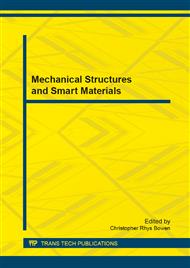p.324
p.328
p.332
p.337
p.343
p.348
p.352
p.357
p.361
Analysis of the Effect of External Factors to the Propulsion by Inertial Centrifugal Force of Rotating Mechanism
Abstract:
The idea of inertial propulsion using rotating parts is always attractive, but great controversy also exists. Some researchers even completely negate this idea in principle, they think it would never be possible to create directional movement by the inertial force. Theory and experimental results show that, in certain conditions, directional movement can be realized by the internal inertia force of the device. In this paper, the influence of the friction condition between the propulsion devices which using rotating eccentric mass to generate inertia force and the external supporting surface on the effect of propulsion has been analyzed. The results show that, when there is friction between the device and the supporting surface, the rotary of eccentric mass in the device will allow the device to produce motion in a given direction; if the parameters of propulsion device (eccentric mass and eccentricity) and the rotary speed of the eccentric mass are given, the friction condition between the device and the support surface will affect the characteristics of directional motion.
Info:
Periodical:
Pages:
343-347
Citation:
Online since:
January 2014
Authors:
Keywords:
Price:
Сopyright:
© 2014 Trans Tech Publications Ltd. All Rights Reserved
Share:
Citation:


